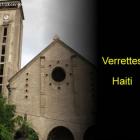ADVERTISEMENT
Parsley Massacre - Haiti Observer Blog
Parsley Massacre, Haiti Observer Blog. Read the following articles about Parsley Massacre
Who in Haiti remember Spanish word for parsley: perejil, with its "r"
Who is likely to forget this hard-learned lesson centered around the word 'parsley' and what it meant to be Haitian across the border in the Dominican Republic then, and what it still means now? Years ago, the parsley massacre occurred, epitomizing genocide for the island that houses both Haiti and the Dominican republic.
The year was 1938 and the then President of the larger country, President Trujillo, ordered the killing of over 20, 000 people during five days in October that year. Their crime was for being Haitian, and their fates hinged on whether or not they could pronounce the Spanish word for parsley, with the rolling "R" that is synonymous with the Spanish language. Of course, the French influence gave them away for Haitian, as they condemned themselves with the more guttural pronunciation of the word, and they were subsequently killed.
Parsley Massacre of Rafael Trujillo, one of the least-known genocides
Antihaitinismo isn't an abstract term that Haitians hide behind when they want to speak badly about their treatment in the Dominican Republic. Such an outlook depends on the thing being inchoate and not substantiated by decades of example and legislative proof.
When, in 1937, the Dominican Republic despot, Rafael Trujillo ordered the execution of somewhere between 9,000 and 20,000 Haitian immigrants, the world took scant notice, and the country, Haiti's closest neighbor, continued to fester in its anti-Haiti doctrines and practices. This wrong, not punished for what it was, helped shaped the minds that today, in 2013, have passed a cruel piece of legislature that would strip Haitians, born in or out of the Dominican Republic of the right of citizenship.
Dominicans are not Racists, they just don't like Black Haitians
Why would anyone think the people of the Dominican republic are racists. We are tolerant, and welcome foreigners just like all civilized societies. We just don't like "Black Haitians"
Where do you think this statement came from. You wouldn't believe it but this is a true statement coming out of the mouth of a Dominican in Miami.
This is how we set this: A good friend of mine who is white asked the other day to a Dominican Immigrant why is it that Dominicans and Haitians are often in conflict? To his surprise, his Dominican friend came with the above answer.
Will Haitians in Dominican Republic have to pronounce "Perejil" all over again?
The process of Identifying and classifying Haitian-Dominican or any Dominican with Haitian origin has began. Within the next 30 Days, this Identification is to take place.
"Mezanmi Nin pot Dominikin Ki Gin Tit Tankou: Ti Pye, Mezadie, Petit Frere, ....Pap Citwayen Peyi Sa Anko"
The Dominican Government announced yesterday (Wednesday, October 23, 2013) that they will comply with the Constitutional Court ruling which outlines a foreigner's pathway to Dominican citizenship
This position of the Dominican government to follow the Court ruling came after a meeting by president Danilo Medina who has noted the full respect of the independence of the branches of government and constitutional powers. In the Dominican Republic
Stenio Vincent Uneasy Alliance with the Dominican Republic
Stenio Vincent was the 30th President of Haiti, from 1930-1941. Born of mixed-race parentage, he earned his law-school degree by his 18th birthday. He rose to prominence in the leadership role in the Chamber of Deputies before running for the presidency. As part of his political platform, he voiced extreme disapproval of the U.S. occupation of Haiti. Vincent won the National Assembly majority vote and assumed office in October 1930.
By 1934, after U.S. military forces pulled out, Stenio Vincent began oppressing opposition leaders, spying on and incarcerating them. Now a loyal supporter of U.S. democracy, he became signatory on a trade agreement with them. In 1935, he won the popular vote, keeping him in office until 1941.
Parsley Massacre - Slaughtering of Haitians By The Dominicans
Haiti was under military occupation for around 19 years. In the Dominican Republic from 2nd October 1937 to 4th October 1937 fifteen thousand to twenty thousand immigrant workers from Haiti were massacred. Machetes and bayonets were used to slaughter them by big landowners and the army in Dominican Republic.
Pitchforks were used to spear women and heads of infants were smashed against the walls. No firearms were used in the Parsley Massacre. The ones who tried to escape were captured at the border and then killed.
Our objective is to share with you news and information about Haiti and the people of Haiti. Traditions, habits and the way we were or grew are alive in this site. We highly recommend that you Subscribe to our Newsletter and also share with us some of the things that are memorable and made us unique people.

 Verrettes, Haiti
Verrettes, Haiti  Saint Michel de L 'Atalaye
Saint Michel de L 'Atalaye  Life After Death
Life After Death  Marmelade, Haiti
Marmelade, Haiti  Newsletter
Newsletter